The Norwegian oil and gas company Equinor Energi AS, operator of the production license 1128 offshore Norway, has concluded the drilling of wildcat well 6605/1-2 S and appraisal well 6605/1-2 A and made a gas discovery, the Norwegian Petroleum Directorate said Wednesday.
The wells were drilled using Odfjell Drilling's Deepsea Stavanger semi-submersible drilling rig, around 23 kilometers south of the Irpa field, which is currently being developed in the northern part of the Norwegian Sea, and 350 kilometers west of Sandnessjøen.
The objective of well 6605/1-2 S was to prove petroleum in Upper Cretaceous reservoir rocks in the Springar Formation. The objective of appraisal well 6605/1-2 A was to confirm the discovery in a downfaulted neighboring segment.
The well 6605/1-2 S encountered three sandstone layers in the Springar Formation, with moderate to good reservoir quality. The uppermost sandstone layer, about ten meters thick, was gas-bearing. In the 35-meter middle sandstone layer, a 2-meter gas column was encountered, and the gas/water contact was proven at about 3190 meters below sea level. The lowest sandstone layer was 25 meters thick and water-bearing.
The well 6605/1-2 A proved a 12-meter gas column in the uppermost sandstone layer, with moderate to good reservoir quality. No gas/water contact was encountered. The deeper sandstone layers are water-bearing.
Pressure data indicates communication both vertically between the three sandstone layers and horizontally between the two wells, in both the water and hydrocarbon zones. The total gas column proven in the two wells amounts to 29 meters.
Preliminary estimates place the size of the discovery - named Obelix Upflank - between 2 and 11 billion standard cubic meters (Sm3) of recoverable gas. The licensees will assess further delineation of the discovery and tie-in to the Irpa field.
The wells were not formation-tested, but extensive data collection and sampling have been carried out.
These are the first and second exploration wells in production licence 1128, which was awarded in APA 2020.
The wells 6605/1-2 S and 6605/1-2 A were drilled to respective vertical depths of 3330 meters and 3327 meters below sea level and were terminated in the Springar Formation in the Upper Cretaceous.
The water depth at the site is 1190 meters. The wells have been permanently plugged and abandoned.
Separately, Equinor confirmed making the discovery, too.
"Equinor and partners Wintershall Dea and Petoro have made a commercial gas discovery in production licence 1128 estimated at between two and eleven billion standard cubic metres of recoverable gas, or about 12.6-69.2 million barrels of oil equivalent," the company said.
"This is the first discovery made on the Norwegian continental shelf (NCS) in 2023, and the first wells in the Equinor-operated production licence awarded in the APA award in 2020," Equinor said.
Grete B. Haaland, Equinor’s senior vice president for Exploration and Production North said:“We need to find more gas on the NCS. Discoveries near existing infrastructure requires less volume in order to be commercially developed, and can be quickly put on stream with low CO2 emissions. We will together with our partners consider tie-back of this discovery to Irpa, for which we recently submitted a plan for development and operation."
Irpa is a subsea development that will be tied back to the Aastad Hansteen platform. Irpa will extend the life of Aasta Hansteen by seven years, and contribute to more activity at the supply base in Sandnessjøen, for the helicopter base in Brønnøysund, and for the operations organization in Harstad.
 Credit: NPD
Credit: NPD



